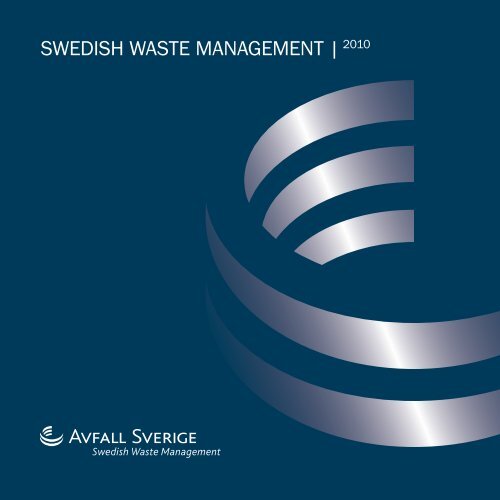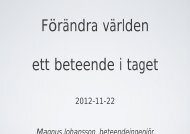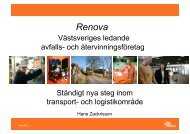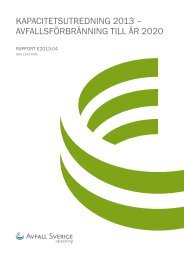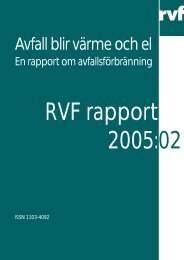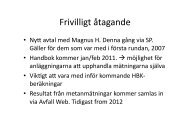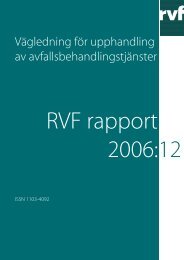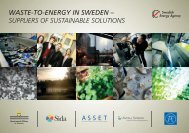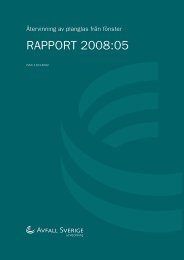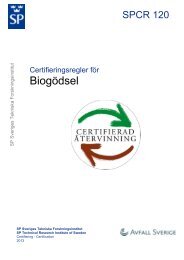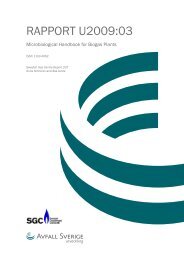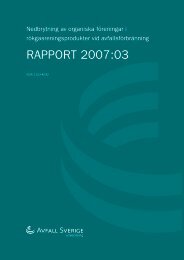SWEDISH WASTE MANAGEMENT |2010 - Avfall Sverige
SWEDISH WASTE MANAGEMENT |2010 - Avfall Sverige
SWEDISH WASTE MANAGEMENT |2010 - Avfall Sverige
Create successful ePaper yourself
Turn your PDF publications into a flip-book with our unique Google optimized e-Paper software.
<strong>SWEDISH</strong> <strong>WASTE</strong> <strong>MANAGEMENT</strong> 2010CONTENTSPREFACE 3HOW <strong>SWEDISH</strong> <strong>WASTE</strong> <strong>MANAGEMENT</strong> WORKS 4COLLECTION AND TRANSPORT 6<strong>WASTE</strong> QUANTITIES 2009 8HAZARDOUS <strong>WASTE</strong> 10BATTERIES 12<strong>WASTE</strong> FROM ELECTRICAL AND ELECTRONIC EQUIPMENT (WEEE) 13MATERIAL RECYCLING 14BIOLOGICAL TREATMENT 16<strong>WASTE</strong>-TO-ENERGY 20LANDFILLING 24<strong>WASTE</strong> ECONOMICS 26<strong>WASTE</strong> OTHER THAN HOUSEHOLD <strong>WASTE</strong> 28<strong>WASTE</strong> AGENDA 29GLOSSARY 32ABOUT AVFALL SVERIGE – <strong>SWEDISH</strong> <strong>WASTE</strong> <strong>MANAGEMENT</strong> 35STAFF 352
<strong>SWEDISH</strong> <strong>WASTE</strong> <strong>MANAGEMENT</strong> 2010PREFACEWaste management is an important part ofthe infrastructure of the society and of thesociety’s use of raw material, nutritional substancesand energy. Through the right wastetreatment, we can contribute to preventingclimate changes and use waste as a resource.Here are some examples:• Energy recycling through incineration –Waste-to-Energy – gives heating and electricity,and waste will thus replace fossilfuels.• Separated food waste that goes to digestiongives both biogas, which can be used forvehicle fuel, and digestate, which is anexcellent nutritional substance.• Recycled material saves energy and replacesvirgin raw materials.In 2009, household waste volumesdecreased by close to 5 percent compared tothe year before. 98.6 percent of the householdwaste is recycled, only 1.4 percent goes tolandfills. The waste quantity that goes to landfillhas decreased by 50 percent compared to2008.The quantity of treated household wasteamounted to 4,485,600 tons. Divided overthe population, each Swedish resident produces480.2 kg of waste per year. In 2008,the quantity of treated household wasteamounted to 4,731,660 tons, or 511.2 kg perperson.Reduced waste volumes is something thatSweden, and all of Europe needs to strive foralso in the long term. Through the FrameworkDirective for waste, the EU requires the memberstates to take measures to prevent theproduction of waste. The member states shallbring forward waste reduction plans which aimat reducing the waste volumes by 2020. At thenational level, <strong>Avfall</strong> <strong>Sverige</strong> – Swedish WasteManagement is one of the actors in this process.Together with the Swedish EnvironmentalProtection Agency, we run a three-year projectcalled ”European Week for Waste Reduction”which aims at raising awareness of the wastepolicy within the EU and the member states,and show the direct effect that consumptionhas on the environment and on the greenhouseeffect. It is also essential to emphasizethe correlation between waste minimizationand sustainable development.The annual report ”Swedish WasteManagement”, is published by <strong>Avfall</strong> <strong>Sverige</strong>for the 12 th year in a row. It briefly describeshow household waste management works inSweden. Factual information that has beenupdated based on the latest available statistics,is presented in text, figures and tables.The statistics given in ”Swedish WasteManagement 2010” is collected from the webbasedstatistics system, <strong>Avfall</strong> Web, and fromthe producers’ organizations.<strong>Avfall</strong> Web was launched by <strong>Avfall</strong> <strong>Sverige</strong>– Swedish Waste Management in the spring of2008, due to local authorities’ request of asystem which enabled comparisons, follow-upand statistics intended for waste planning.<strong>Avfall</strong> Web also gives access to basic data forcomplete national waste statistics.The report “Swedish Waste Management” isintended for those active in the waste industry,decision-makers, authorities, educationalinstitutions, media, and other interested parties.Malmö, June 2010Weine Wiqvist,Managing Director <strong>Avfall</strong> <strong>Sverige</strong>3
<strong>SWEDISH</strong> <strong>WASTE</strong> <strong>MANAGEMENT</strong> 2010HOW <strong>SWEDISH</strong> <strong>WASTE</strong> <strong>MANAGEMENT</strong> WORKSWaste shall be treated in such a way that themaximal environmental and social benefitsare achieved. All parties participate in thiswork – from producers to households.The local authorities are responsible for thehousehold waste, the producers are responsiblefor their various product groups, and theoperators in the sector are responsible for takingcare of all waste which is not householdwaste.The households have the responsibility toseparate and deposit waste at the differentcollection points available. The householdsalso have the responsibility to follow the regulationsfor waste management within theirmunicipality.Waste management is prioritized accordingto a five step waste hierarchy:• waste prevention• reuse• material recycling• recovery – such as energy recovery• disposalExceptions from the hierarchy may be necessaryfor technical, economical or environmentalreasons.EU decisions set the frameworks for theSwedish waste management. The environmentalobjectives of the Swedish Parliament governthe waste management and its environmentalaspects. These are the environmentalobjectives for the waste sector:• A 50 percent reduction of waste going tolandfills, excluding mining waste, by theyear 2005 compared to levels in 1994.• By 2010, at the latest, a minimum of 50percent of household waste shall be recoveredthrough material recycling, includingbiological treatment.• By 2010 at least 35 per cent of food wastefrom households, restaurants, institutionalcatering and shops is to be recycled by biologicaltreatment. The objective refers tosource-separated food waste intended forboth home composting and central heating.• By 2010, at the latest, food waste and consequentlyall equivalent waste from foodindustries etc., shall be recycled throughbiological treatment. The objective refers towaste that has not been mixed with othertypes of waste, and which subsequent totreatment is of adequate quality for use incrop production.• By 2015, at the latest, at least 60 percentof phosphorus pollution in effluent shall betreated and used on productive lands, ofwhich at least half should be used on arableland.Several of these environmental objectiveshave been fully or almost fully achieved.The most important treatment methods forwaste are:• material recycling• biological treatment• Waste-to-Energy• landfillHazardous waste can be treated with one orseveral of these methods, depending on thecharacter of the waste.Recycling of packaging, paper, scrap, electricwaste, and batteries reduce the environmentalimpact and save energy and resources.Biological treatment is implementedthrough anaerobic digestion or composting.Anaerobic digestion produces biogas whichcan be used as vehicle fuel. The biogas producedfrom waste is equivalent to millions ofliters of petrol. Anaerobic digestion also producesdigestate which is an excellent nutrient.Composting produces long-lasting fertilizerused as soil improver in gardens, parks and forground installations.Waste-to-Energy is an effective and environmentallysafe method for producing energyfrom waste. Every year, it produces heatingwhich corresponds to the need of 820,000average households, approximately 25 percentof all the district heating produced. It alsoproduced electricity which corresponds to theneed of more than 275,000 houses.Landfilling is a treatment method for wastewhich cannot or should not be treated in anyother way. Landfilling means that waste is keptin a long-term safe way, and this treatmentmethod is controlled by a strict regulatoryframework.The local authorities can choose how toorganize the waste management. This possibilityof municipal self-government is laid downin the constitutional law.4
<strong>SWEDISH</strong> <strong>WASTE</strong> <strong>MANAGEMENT</strong> 2010The local authorities are free to choosemanagement mode and municipal undertakings,separate or joint with other municipalities.Cooperation is also possible in a jointcommittee or a local government federation.There are also local authorities who cooperateon specific matters, such as joint procurements.To many local authorities collaborationis a natural solution to attain the best possibleenvironmental and social benefits, to achievecost-efficient treatment and to guarantee thecompetence required.In 73 percent of the Swedish municipalities,the collection of household waste is managedby external actors, private companies,while in the rest, it is managed by the municipalitiesthemselves. In the same way, wastetreatment is effected either by the municipalitiesthemselves or by an external actor, oftena municipal enterprise or sometimes a privatecompany.5
<strong>SWEDISH</strong> <strong>WASTE</strong> <strong>MANAGEMENT</strong> 2010MATERIAL RECYCLING COLLECTION AND TRANSPORTThere are various systems for collection andtransport of household waste. At the municipalities’manned recycling centers, the householdsthemselves drop off bulky waste, electronicwaste and hazardous waste. Bulkywaste is household waste which is too heavy,too bulky or for other reasons inappropriate forcollection in bags or bins. It may be for examplebroken furniture, toys, bicycles, or perambulators,but can also include garden waste orcertain demolition waste.In 2009, the households dropped off 1.5million tons of bulky waste, most of which washanded to the manned municipal recyclingcenters. A smaller part was collected throughcurbside collection. The bulky waste volumescorrespond to 160 kg per person. There areabout 600 recycling centers throughout thecountry, and in total they receive about 20 millionvisits annually.The volumes of bulky waste and hazardouswaste that are handed to the recycling centershave increased significantly in recent years. Inseveral municipalities the recycling centershave, as a result, undergone adaptations andmodernizations. Several small-sized recyclingcenters have closed down when the munici-palities build new and bigger centers that arebetter suited to the waste quantities andnumber of visitors.Several of the recycling centers in the countryhave had problems with burglaries andthefts in recent years. There have also beenincidents when staff has been threatened.Due to this, most of the bigger and recentlybuilt recycling centers have installed electricfences, which have reduced the number ofburglaries considerably.In order to improve the safety, and for thesake of a functional system for access controlthat would enable more accurate visiting statistics,several of the municipalities have alsointroduced a barrier gate system at the recyclingcenters. This system is often combinedwith an entry card which gives households theright to a certain number of free visits. For asmall fee, smaller entrepreneurs may also usethe services offered at the recycling centers inseveral of the municipalities.The producers’ system includes approximately5,800 unmanned recycling stations forpackaging and paper that are located aroundthe country. The collection systems should beformed in consultation with both producersand local authorities. The recycling stationshave separate bins for newspaper and variouspackaging material. Several municipalitieshave implemented curbside collection ofmaterial from apartment blocks and detachedhouse properties that fall under producer’sresponsibility, a collection system which is onthe increase.The household waste in bins and bags maybe collected either as a mixed fraction intendedfor Waste-to-Energy or in separate fractions– one for food waste and one for combustiblewaste.The most common systems for collection ofsource-separated food waste is by separatebins – one for bio-waste and one for combustiblewaste – by multi-compartment bin, or byoptical sorting. Optical sorting requires thehouseholds to separate their waste into differentcoloredbags that are placed into the same container.The bags are then taken by the wastecollection vehicle to an optical sorting facilitywhere the bags are separated automaticallyfor the right treatment.Collection in bags constitutes a workingenvironment risk and has as a result become6
<strong>SWEDISH</strong> <strong>WASTE</strong> <strong>MANAGEMENT</strong> 2010considerably less common. Mixed combustiblewaste from single-family houses is in mostcases collected in 190 liter wheelie bins andemptied every other week. Other than this,there are a number of different bag and binsizes which are collected and emptied in variousintervals. Waste from apartment blocksare normally collected weekly.Traditional back-loading vehicles are stillthe most common when it comes to waste collection,but the technology for multi-compartmentedvehicles is developing and becomingmore and more popular, while side-loadingvehicles account for a more constant share ofthe operators’ vehicle fleet. An increasingnumber of vehicles use biogas as fuel, whichthe local authorities may control through purchasingrequirements.Waste collection previously led to manywork-related injuries. Daily heavy lifting waspart of the job in the past, and waste collectionrequired workers to be in good physicalcondition. Only a few waste collectors wereable to work until the average retirement age.Today the situation is different. Bags havebeen replaced with bins or other types of containers.Manual handling of waste is beingreplaced with new technology and automatedsystems, such as refuse vacuum pipes andunderground container systems. Both of thesesystems are on the increase, particularly inbigger cities. One of several advantages is thatthey do not require heavy manual handling.From the point of view of health and safety atwork, vacuum collection systems are goodsince they are sealed and completely automated.This type of collection system reducesthe need for waste transportation, especiallyin residential areas.There are two kinds of vacuum collectionsystems, a stationary system and a mobilesystem. With the stationary system the wasteis collected using air in an automated vacuumsystem. It is thereafter transported throughunderground tubes, which connect the inletswith big containers placed in a terminal. Withthis technique the waste can be transportedup to a distance of two kilometres from theinlets. The number of containers varies anddepends on the one hand upon the number ofcollected fractions, and on the other hand onthe waste volumes. The containers are collectedby hook-lift vehicles.The mobile vacuum collection system alsouses air to collect the waste. However, herethe vacuum technique originates from thevehicle. Positioned under each input is a storagetank. The tanks are connected, via anunderground pipe system, to a so called dockingpoint which can be placed at a maximumdistance of 300 meters from the tanks. Thevehicle connects to the docking point for emptying,the vacuum system is turned on and airtransports the waste from the different storagetanks to the docking point and onto thevehicle. Mobile vacuum collection systemsrequire specialized vehicles.Another collection system that is on the riseis the underground container system. By placingcontainers underground, the need forspace on the street level is reduced. The temperaturebelow the street level, where thewaste is contained, is relatively low, whichprevents odor, and the containers are easilyemptied with a crane truck. There are alsounderground containers that are emptied withfront-loading vehicles. Since the undergroundcontainers can hold bigger volumes, the levelof transports is reduced.7
<strong>SWEDISH</strong> <strong>WASTE</strong> <strong>MANAGEMENT</strong> 2010<strong>WASTE</strong> QUANTITIES 2009In 2009, the quantities of household wastewere reduced for the first time since the1990s. The household waste volumesdecreased by close to 5 percent compared tothe year before. The decrease is very likely aresult of the recession. There is a close connectionbetween economic situation and consumption,and between consumption andwaste quantities - lower consumption leads toreduced waste quantities.In 2009, the quantity of treated householdwaste amounted to 4,485,660 tons. Dividedover the population, each Swedish residentproduces 480.2 kg of waste per year. 98.6percent of the household waste is recycled,only 1.4 percent goes to landfills. That is a 50percent reduction of landfill compared to2008.1,586,600 tons of packaging, paper, wastefrom Electric and Electronic Equipment(WEEE), and metal from the municipal recyclingcenters was treated through materialrecycling. This is a decrease by 71,200 tons,or 4.3 percent, compared to 2008. 35.4 percentof the household waste is recycled.Biological treatment – anaerobic digestionand composting – increased in 2009. 617,680tons of household waste was treated biologicallyin 2009. That is an increase of more than20,000 tons, 3.4 percent, compared to theyear before. Today, 13.8 percent of all householdwaste goes to biological treatment.This means that 49.2 percent of householdwaste is recovered either by material recyclingor by biological treatment. The Parliament’senvironmental objective at 50 percent is thusnot far from being achieved.2,173,000 tons of household waste went toWaste-to-Energy, a decrease of 5.2 percent orclose to 120,000 tons. 48.4 percent of thehousehold waste is treated through incinerationwith energy recovery.Landfill disposal continues to decrease.63,000 tons of household waste went to landfillsin 2009. This is a decrease of close to77,000 tons, or 55 percent, compared to theyear before.Hazardous waste represents 1 percent ofthe treated household waste. 45,380 tonswas collected in 2009. An increase by littleover 2,000 tons, or 4.8 percent, compared to2008.8
<strong>SWEDISH</strong> <strong>WASTE</strong> <strong>MANAGEMENT</strong> 2010QUANTITY OF TREATED HOUSEHOLD <strong>WASTE</strong> 2005–2009 (TONS)2005 2006 2007 2008 2009Hazardous waste 26,400 38,960 40,880 43,320 45,380Material recycling 1,474,280 1,657,520 1,737,720 1,657,840 1,586,600Biological treatment 454,450 469,880 561,300 597,280 617,680Waste-to-Energy 2,181,890 2,107,860 2,190,980 2,292,970 2,173,000Landfill 210,110 226,000 186,490 140,250 63,000Total 4,347,130 4,500,220 4,717,370 4,731,660 4,485,660QUANTITY OF TREATED HOUSEHOLD <strong>WASTE</strong> 2005–2009 (KG/PERSON)2005 2006 2007 2008 2009Hazardous waste 2.9 4.3 4.5 4.7 4.9Material recycling 162.9 181.9 189.2 179.1 169.9Biological treatment 50.2 51.6 61.1 64.5 66.1Waste-to-Energy 241.2 231.3 238.6 247.7 232.6Landfill 23.2 24.8 20.3 15.2 6.7Total 480.5 493.8 513.7 511.2 480.2QUANTITY OF TREATED HOUSEHOLD <strong>WASTE</strong> 2005–2009 (%)2005 2006 2007 2008 2009Hazardous waste 0.6 0.9 0.9 0.9 1, 0Material recycling 33.9 36.8 36.8 35.0 35.4Biological treatment 10.5 10.4 11.9 12.6 13.8Waste-to-Energy 50.2 46.8 46.4 48.5 48.4Landfill 4.8 5.0 4.0 3.0 1.4Total 100 100 100 100 100Källa: <strong>Avfall</strong> <strong>Sverige</strong>Summary 1999-2009tons2,500,0002,000,0001,500,0001,000,000500,0000-99 -00 -01 -02 -03-04 -05 -06 -07 -08 -09Hazardous wasteLandfillingBiological treatmentMaterial recoveryIncineration with energy recovery543210milj. ton2005 2006 2007 2008 2009<strong>WASTE</strong> STATISTICS 2010<strong>Avfall</strong>smängderna minskar samtidigtsom återvinningen ökar. 2009 återvannshela 98,6 procent av hushållsavfalleti <strong>Sverige</strong>, endast 1,4 procentdeponerades.Total quantity of treated household waste Tons %Hazardous waste 45,380 1.0Material recovery 1,586,600 35.4Biological treatment 617,680 13.8Incineration with energy recovery 2,173,000 48.4Landfilling 63,000 1.4Total 4,485,660 1009
<strong>SWEDISH</strong> <strong>WASTE</strong> <strong>MANAGEMENT</strong> 2010HAZARDOUS <strong>WASTE</strong>In 2009, 45,380 tons of hazardous waste wascollected from households, an increase of 4.8percent compared to 2008. On average, 4.9kg of hazardous waste per Swedish residentwas handed in. The figures include impregnatedwood, a fraction which has steadilyincreased over recent years and today constitutes55 percent of all hazardous waste fromhouseholds. In 2009, 24,760 tons of impregnatedwood was collected, an increase of 16percent compared to the year before.Hazardous waste, including impregnatedwood, represented 1 percent of the householdwaste.Hazardous waste can be toxic, carcinogenic,corrosive, mutagenic, ecotoxic, infectious, orflammable. Hazardous substances may occurin very small amounts in some products, butcould all together cause great damage if theyend up in the wrong place. It is therefore importantthat hazardous waste is separated fromother waste and handed in correctly.Local authorities are responsible for hazardoushousehold waste. The responsibilityencompasses collection, transport, and treatment.The responsibility is regulated by theEnvironmental Code, the Waste Collection andDisposal Ordinance, and the Municipal WasteRegulation Ordinance.Households are responsible for separatinghazardous waste from other household waste.It is regulated in the Municipal WasteRegulation Ordinance.At a national level, Sweden lacks a follow-upsystem for hazardous waste from industriesand other types of businesses. There are noprecise statistics of the amounts of hazardouswaste from industries, but according to theofficial Swedish waste statistics, reported tothe EU by the Swedish EnvironmentalProtection Agency, Swedish households andenterprises produced 2.8 million tons of hazardouswaste in 2006, including scrap vehicles,electrical waste etc.The most common collection system for thehazardous household waste is through drop offat the manned municipal recycling centers.Several municipalities have stopped using theunmanned recycling stations and have insteadintroduced curbside collection. Approximatelyone third of all municipalities in the countryoffer curbside collection, often in combinationwith several other collection systems.Hazardous waste handed to collection ortreatment facilities often require pre-treatmentin order to facilitate further treatment. Sincehazardous waste may contain substanceswhich are to be phased out of the ecocycle, thetreatment often aims at destroying these substances.Substances which cannot be renderedharmless or be reused will be disposedto landfills. In these cases it is important thatthe waste is chemically and physically stableso hazardous substances do not leak out tosurrounding areas.New treatment methods for recycling hazardouswaste have been developed, whichinvolve the separation of hazardous substancesand recycling of the remaining parts. Themethod is used for treatment of, for instance,paint tins and oil filters. Toxic and poorly degradablesubstances, such as pesticides and10
<strong>SWEDISH</strong> <strong>WASTE</strong> <strong>MANAGEMENT</strong> 2010other hazardous chemical waste, are incineratedin specialized furnaces at high temperatures.Contaminated soil can be decontaminatedthrough biodegradation.Impregnated wood contains ecologicallyharmful substances such as arsenic, creosote,and copper. Collected wood is chipped andincinerated in specially licensed waste-to-energyplants.<strong>Avfall</strong> <strong>Sverige</strong> is running a national campaignin 2009-2010, to inform the public abouthazardous waste. The campaign is arranged incooperation with the Swedish local authorities.The primary purposes of the campaign are tomotivate people to deposit hazardous wasteand to use less harmful, chemical products.Pharmaceuticals are not classified as hazardouswaste, with the exception of cytostatics,but should for environmental reasons behanded in separately. As from December 15,2009, the pharmacies are responsible for collectionof pharmaceutical waste. In 2009, fully1,100 tons of pharmaceutical waste was collected,which is an increase of 4 percent comparedto 2008.QUANTITY OF HAZARDOUS <strong>WASTE</strong> COLLECTED 1999 – 2009tons50,00045,00040,00035,00030,00025,00020,00015,00010,0005,0000-99 -00 -01 -02 -03 -04 -05 -06 -07 -08 -09Quantity of hazardous waste collected (excl. impregnated wood)Quantity of hazardous waste collected (inc. impregnated wood)11
<strong>SWEDISH</strong> <strong>WASTE</strong> <strong>MANAGEMENT</strong> 2010BATTERIESA new producer’s responsibility for batterieswas taken into effect on January 1, 2009. Itmade battery producers responsible for collection,treatment, recycling, and disposal ofall batteries regardless of when they appearedon the market. The producers are also responsiblefor running national information activities.Currently, this is done in cooperation withthe municipalities. The two Swedish companiesEl-Kretsen and Blybatteriretur, which representthe producers, are cooperating withSwedish Waste Management – <strong>Avfall</strong> <strong>Sverige</strong>on this matter. Most municipalities managethe collection of portable batteries within themunicipality, against a negotiated remunerationfrom the producers.In 2009, 1,450 tons of portable batteriesand 273 tons of incorporated batteries werecollected, on average 185 grams per Swedishresident. This is a reduction of 6 percent comparedto 2008.The municipalities collected 5,275 tons oflead-acid batteries, on average 0.6 kg perSwedish resident, which is an increase of 4percent compared to the year before.All collected batteries are taken care of andseparated after chemical content before beingsent to recycling or landfilling.• Lead-acid batteries go to recycling and thebattery lead is used in new batteries.• Batteries containing nickel-cadmium go totreatment where the cadmium is used in socalled vented nickel-cadmium batteries,which are commonly used in industries.Nickel is also recycled but goes to steelworks.• Nickel-metal hydride batteries are recycledin facilities where the nickel can be returnedinto the cycle.• Batteries containing mercury go to reprocessing.The Parliament has decided not torecycle mercury. This is why work is currentlyat hand to extract the mercury frombatteries, so it can be phased out of therecycling system and have safe direct disposal.• Lithium batteries are treated in facilitieswhere reuse of cobalt is possible, for exampleas additive in the steel industry.All batteries shall be collected and materialrecycledto the fullest extent possible.Collection of small batteries 2003 – 2009kg/person0.250.200.150.100.050-03-04 -05 -06 -07 -08 -0912
<strong>SWEDISH</strong> <strong>WASTE</strong> <strong>MANAGEMENT</strong> 2010<strong>WASTE</strong> FROM ELECTRICAL AND ELECTRONIC EQUIPMENT (WEEE)In 2009, 143,850 tons of waste from electricaland electronic equipment – the abbreviationWEEE – was collected, which is a decreaseof 5.2 percent compared to 2008. On average,15.4 kg WEEE per person was collected in2009, compared to 16.3 kg per person theyear before. There are close connectionsbetween economic situation, consumptionand waste production. The reduction is thereforelikely to be a result of the recession and ofsmaller and lighter electric and electronicproducts.Since the producer’s responsibility wastaken into effect in Sweden, local authoritiesand producers have cooperated in the managementof WEEE. Together, <strong>Avfall</strong> <strong>Sverige</strong> –Swedish Waste Management, the SwedishAssociation of Local Authorities and Regions(SALAR), and the electrical producers’ servicecompany, El-kretsen, created the system in2001. The collaboration means that localauthorities assume responsibility for the collectionof electronic waste from households,and the producers are responsible for its treatment.Collection of electronic waste from householdsis primarily carried out at the mannedmunicipal recycling centers, of which there areapproximately 600 throughout the country. Insome municipalities this is complemented by are incinerated in waste-to-energy plants, andcurbside collection. <strong>Avfall</strong> <strong>Sverige</strong> – Swedish metal is recycled in smelting plants.Waste Management and El-Kretsen collaboratewith several local authorities on differentprojects to develop these collection systems.An example of this is the collection of lightbulbs and smaller electric and electronic wasteinto small containers, which are placed instores and other public places.WEEE is pretreated through sorting and dismantlingbefore it is sent on for further treatment.Pretreatment is carried out in certifiedfacilities, and later forwarded to final treatmentor recycling.Components containing hazardous substances,i.e. hazardous waste, are treated inapproved treatment facilities. Plastic casingsFluorescent tubes and low-energy bulbs containmercury. These products are thereforeseparated and treated in a closed process. Theglass and metal contents are recycled, andmethods enabling the recycling of the phosphoruspowder with its mercury content, isbeing developed.It happens that old electronic products aredonated to other countries as charity, for whatmay seem as a good cause, but this is howevernot environmentally friendly. From an environmentalpoint of view, it is better to have theseproducts recycled in Sweden, where we havemethods to treat such waste in an environmentallysound way.COLLECTION OF WEEE 2003-2009tons200,000150,000100,00050,0000-03 -04 -05 -06 -07 -08 -09Återvunnet elavfall13
<strong>SWEDISH</strong> <strong>WASTE</strong> <strong>MANAGEMENT</strong> 2010MATERIAL RECYCLINGMaterial recycling including biological treatmentaccounted for 2,204,280 tons, in 2009,which represents 236.0 kg per person. TheSwedish Parliament has set the goal of havingat least 50 percent of household waste goingto material recycling, including biological treatment,by 2010.In 2009, the material recycling includingbiological treatment reached 49.2 percent.The part of material recycling which includespackaging, electronic waste, as well as bulkywaste collected as metal fraction in municipalrecycling centers, decreased to 1,580,600tons, 169.9 kg per person and corresponds to35.4 percent of all treated household waste.Metal waste from households handed to therecycling centers, such as bicycles and gardenfurniture, increased until 2007, and hasdecrease after that. However, between 2008and 2009, this fraction increased with close to18,000 tons. In 2009, 169,920 tons of metalwaste was collected for recycling, which represents18.2 kg per person.One explanation for the reduced quantitiesof waste going to material recycling is the economicrecession. Reduced consumption leadsto reduced waste quantities. At the same time,recycling of newspapers and some types ofpackaging has increased, meaning that agreater extent of packages and newspapersput on the market gets recycled.The presented figures on quantities of cardboard,plastic and metal packaging are basedon packaging quantities reported by productioncompanies, which pay fees to the socalled REPA Register (producer responsibilityregister for packaging).Packaging is mainly collected through thesome 5,800 unmanned recycling stations thatproducers control. However, it can also be collectedat the manned municipal recycling centers.Several municipalities have introducedcurbside collection of newspapers and packaging,which is a collection system that isbeing increasingly applied.The collected newspaper quantitiesdecreased to 420,000 tons, in 2009. The recyclingrate however went up to 91 percent; thetarget rate of 75 percent has long beenreached.The amount of office paper that was collecteddecreased to 118,000 tons, which isabout 72 percent of the amount produced onthe market. The result thereby exceeds thevoluntary target of 50 percent.470,700 tons of packaging – paper packaging,paperboard and corrugated cardboard –was recycled in 2009. The joint recycling targetfor all packaging made from paper fiberswas 65 percent, while the recycling rate forlast year was 74 percent.33,400 tons of metal packaging was recycledlast year. The recycling rate reached 73percent and the recycling target of 70 percentwas thus achieved.44,430 tons of plastic packaging went tomaterial recycling in 2009, the recycling ratedecreased to 27 percent. 6,230 tons went toWaste-to-Energy; the recycling rate was 4 percent.The total recycling rate for plastic packaginglanded on 31 percent, which is far fromthe recycling target at 70 percent. As from2009, such plastic packaging material whichgoes to Waste-to-Energy mixed with otherhousehold waste is not included.177,300 tons, or 90 percent, of all glasspackaging was material-recycled. The recyclingrate is 70 percent.<strong>Avfall</strong> <strong>Sverige</strong> is running a national campaignon material recycling in 2010-2011. Thecampaign is arranged in cooperation with theSwedish local authorities. The objective of thecampaign is to increase the knowledge aboutmaterial recycling and improve the confidencein the municipalities work on this matter.14
<strong>SWEDISH</strong> <strong>WASTE</strong> <strong>MANAGEMENT</strong> 2010<strong>SWEDISH</strong> <strong>WASTE</strong> <strong>MANAGEMENT</strong> 2010The Parliament’s[tons] [kg/person] Recovery degree % recycling target %Newspaper 420,000 45.0 91 75Office paper 118,000 12.6 72Cardboard packages 479,700 51.4 74 65Metal packages 33,400 3.6 73 70Plastic packages 44,430 4.8*27 70Glass packages 177,300 19.0 90 70WEEE 117,770 12.6Refrigeration units 26,080 2.8Metal from household waste 169,920 18.2Total 1,586,600 169.9* 4 % waste-to-energy - total recovery rate 31 %** of which 30 % is material recovery.**MATERIAL RECYCLING HOUSEHOLDS 2005–2009 (TONS)2005 2006 2007 2008 2009Newspaper 483,000 483,000 474,000 459,000 420,000Office paper 135,000 153,000 164,000 156,000 118,000Cardboard packages 380,000 486,790 504,000 482,000 479,700Metal packages 33,700 33,700 35,300 32,660 33,400Plastic packages 31,080 42,130 49,120 50,310 44,430Glass packages 155,000 159,000 171,100 174,170 177,300WEEE 101,500 121,900 129,700 122,900 117,770Refrigeration units 25,000 28,000 30,500 28,800 26,080Metal from household waste 130,000 150,000 180,000 152,000 169,920Total 1,474,280 1,657,520 1,737,720 1,657,840 1,586,600Material recycling householdsSource: Förpacknings-och tidningsinsamlingen, El-kretsen, Svensk Returpappersförening and <strong>Avfall</strong> <strong>Sverige</strong>tons2,000,0001,800,0001,600,0001,400,0001,200,0001,000,000800,000600,000400,000200,00001975 1980 19851990 1995 2000 2005 201015
<strong>SWEDISH</strong> <strong>WASTE</strong> <strong>MANAGEMENT</strong> 2010BIOLOGICAL TREATMENTIn 2009, 617,680 tons of household wastewas biologically treated – anaerobic digestionor composting. An increase of 3.4 percentcompared to 2008. In total this means that66.1 kg of waste – green waste and foodwaste – was biologically treated in 2009. Thebiological treatment now stands for 13.8 percentof the total quantity of treated householdwaste.154 municipalities already have more orless implemented systems for collection offood waste, according to a new survey madeby <strong>Avfall</strong> <strong>Sverige</strong> – Swedish WasteManagement. 22 of these only collect foodwaste from restaurants and large-scale kitchens,while the remaining 132 municipalitieshave systems for households as well. The surveyshows that an additional 63 municipalitiesare planning to introduce systems for sourceseparationof food waste. According to <strong>Avfall</strong><strong>Sverige</strong>’s calculations, an estimated 21 percentof the food waste was biologically treatedin 2009.Waste analysis shows that every Swedishresident produces close to 100 kg of foodwaste per year, mainly from fruit and vegetables.The most common system used for sourceseparation of food waste in single-family housesis two separate bins, one for food wasteand one for combustible waste. There is alsothe multi-compartment system where differentfractions are separated into separatecontainers. Another collection system sometimesused, is optic sorting of different coloredbags that are put into the same container.Through anaerobic digestion of biologicalwaste, biogas, consisting of methane and carbondioxide, is produced. Biogas is renewableand the most environmentally sound fuel available,and can be used for vehicle fuel, heatingand electricity generation. In order to use thebiogas as vehicle fuel and in natural gas pipelines,it needs to be processed and upgraded.In 2009, 317,440 MWh of biogas was produced,which is equivalent to 35 million litersof petrol. Biogas is today primarily used asvehicle fuel, a market that is growing fast.Another product from anaerobic digestionprocesses is digestate, an excellent fertilizerwith a rich nutrient content. When using digestateinstead of mineral fertilizers plant nutrientsare preserved, for example phosphorus,which is a limited resource. In 2009,498,720 tons of digestate was preserved,of which 97 percent was used in farming. Theremaining 3 percent was either dehydratedand/or processed with after-composting.In 2009, 630,500 tons of waste was treatedthrough composting, of which 85,620 tonswas food waste. Compost is mainly used assoil improver or in soil mixes.Plants which produce compost or digestatefrom source separated bio-waste, includingfood waste from the food industry, can havetheir product quality marked with certification.16
<strong>SWEDISH</strong> <strong>WASTE</strong> <strong>MANAGEMENT</strong> 2010In 2009, 317,440 MWh of biogas was produced,which is equivalent to 35 million liters of petrol.17
<strong>SWEDISH</strong> <strong>WASTE</strong> <strong>MANAGEMENT</strong> 2010The certification system, which was introducedten years ago, was developed by <strong>Avfall</strong><strong>Sverige</strong> in consultation with the farming andfood industry, compost and digestate producers,soil producers, authorities and experts.SP Technical Research Institute of Sweden isthe inspection body of this certification system.Certification places requirements on theentire waste management chain, from theincoming waste to the final product. A numberof plants are currently going through the processof having their products certified. Tenbiogas plants – Falkenberg, Helsingborg,Kalmar, Kristianstad, Laholm, Linköping,Norrköping, Uppsala, Västerås, andVänersborg – as well as three compostingplants – Borlänge, Malmö, and Örebro – haveobtained certificates.A voluntary undertaking to minimize theemissions from biogas and upgrading plantswas initiated by <strong>Avfall</strong> <strong>Sverige</strong> and furtherdeveloped throughout 2009. Air emissionsmay arise from different stages of biologicaltreatment through anaerobic digestion oforganic material and in biogas upgrading processesin treatment plants. Even though theemissions from biogas plants are low, theyshould be minimized for several reasons.Approximately 30 biogas and upgrading plantshave signed up for the voluntary undertaking.2005 2006 2007 2008 2009Anaerobic digestion 258,070 283,730 356,090 405,580 535,930Composting 459,830 452,390 515,290 568,700 630,500Total biological treatment 717,900 736,120 871,380 974,280 1,166,430of which food waste 118,960 134,990 166,810 162,680 178,770Total quantity of household waste treated biologically* 454,450 469,880 561,300 597,280 617,680Digestate (tons) 251,840 272,730 336,100 389,350 498,720Crude gas (MWh) 161,600 181,270 228,810 280,000 317,440Vehicle gas (MWh) 87,730 106,430 149,230 204,720 262,600Electricity (MWh) 1,260 1,680 1,230 700 O**Heating (MWh) 61,620 63,600 67,960 48,740 41,280Total (MWh) 161,600 181,270 218,410 254,160 303,87018* Including 63,000 tons of home composting.** An increasing share of biogas is being upgraded to vehicle gas. The production of electricity has almost stopped.
<strong>SWEDISH</strong> <strong>WASTE</strong> <strong>MANAGEMENT</strong> 2010Composting Total (tons) of which food wasteAle 1,290 390Alingsås 1,210 1,210Borås 9,260 2,060Borlänge 11,770 11,110Eslöv 9,810 9,810Fagersta 4,220 650Gällivare 6,980 560Göteborg 26,240 20,580Habo 1,660 200Halmstad 6,640 6,640Helsingborg 22,460 17,290Huddinge 17,870 17,590Hässleholm 18,280 16,870Karlskrona 7,500 7,500Karlstad 56,500 2,000Klippan 9,760 7,980Kristinehamn 15,400 200Kungsbacka 3,960 1,800Ludvika 13,210 10,240Luleå 20,410 12,140Malmö 33,180 33,180Mariestad 1,820 240Motala 3,200 3,200Mörrum 12,700 10,650Norrtälje 1,570 1,570Sala 11,700 7,680Simrishamn 5,280 5,280Södertälje 12,900 5,900Tranås 1,730 500Trelleborg 6,410 6,410Täby 29,510 23,570Uppsala 9,180 9,030Västerås 33,180 10,000Ystad 4,720 4,720Örebro 9,800 9,700Östersund 11,610 6,270Överkalix 980 220Total 453,900 284,940Other plants 176 600 176 600The country 630 500 461 540Anaerobic digestion Total (tons) of which food wasteBjuv 47,000 0Boden 4,060 1,860Borås 24,580 12,400Eskilstuna 5,960 3,320Falköping 8,550 4,970Falkenberg 79,400 2,700Helsingborg 64,330 19,020Huddinge 940 680Jönköping 8,890 5,950Kalmar 25,890 0Kristianstad 90,130 4,230Laholm 55,230 2,300Linköping 46,600 0Norrköping 16,000 0Skellefteå 6,540 4,290Skövde 8,230 0Uppsala 9,600 5,020Vetlanda 1,000 1,000Vänersborg 12,700 10,100Västerås 20,300 15,300Totalt 535,930 93,140biological treatment 1975 – 2009tons700,000600,000500,000400,000300,000200,000100,00001975 1980 19851990 1995 2000 2005 201019
<strong>SWEDISH</strong> <strong>WASTE</strong> <strong>MANAGEMENT</strong> 2010<strong>WASTE</strong>-TO-ENERGYIn 2009, 2,173,000 tons of household wastewas treated by incineration with energy recovery– Waste-to-Energy. This was a reduction ofclose to 120,000 tons compared to 2008. Ifdivided over the Swedish population, 232.6 kgof household waste per person was incineratedlast year. Waste-to-energy accounts for48.4 percent of the total quantity of treatedhousehold waste.Expansion and improvement of effectivenesshave led to increased energy recovery inthe last years. In total, 13.9 TWh of energywas produced through incineration, of which12.3 TWh was used for heating and 1.6 TWhfor electricity. That corresponds to electricityfor 275,000 normal sized homes, and heatingfor 820,000 homes. A study on Europeanwaste-to-energy production shows thatSweden has the highest rate of energy recoveryfrom waste incineration.In addition, 2,497,830 tons of other wastewas treated, mainly industrial waste. The totalamount of incinerated waste was 4,670,840tons, which is an increase of 100,000 tonscompared to the year before.The statistical information refers, at firsthand, to plants treating household waste.Energy recovery also takes place in plantswhere household waste is not treated.Sweden has enforced strict regulations onair and water emissions from waste incinerationsince the middle of the 1980’s. Mosttypes of emissions have been reduced by90-99 percent since that time. Apart fromstricter regulations, other factors such as progressingtechnological development andimproved waste separation have contributedto reduced emissions.The remains from incineration consist ofbottom ash from the furnace, 15-20 percentby weight of the treated waste, and flue gastreatment residues, 3-5 percent by weight.Part of the slag goes to landfills, while slaggravel may be used as substitute to naturalgravel in, for example, road and landfill constructionwork. The flue gas treatment residuesare either transported to landfills or usedfor neutralization when refilling mines.There are 29 plants for incineration ofhousehold waste in Sweden, which will continueto expand in 2010 and 2011.Imported waste used for energy recoveryhas increased in recent years, and in 2009,Sweden imported 36,480 tons of householdwaste. Waste has become an increasinglyimportant source in Swedish district heatingsystems. An evaluation on the climate impactof imported waste going to Waste-to-Energy,carried out by <strong>Avfall</strong> <strong>Sverige</strong> - Swedish WasteManagement and the Swedish District HeatingAssociation, shows that the emissions ofgreenhouse gases has decreased due to thewaste import.The main reason for the large emissionreduction is that imports replace waste treatmentin the country of origin. First of all, thishas to do with landfilling, which due to importenables a reduction of methane emissionsconsiderably, a very potent greenhouse gas.The report shows that the transportation ofwaste in comparison only marginally adds tothe greenhouse emissions.According to the EU Framework Directive forWaste, waste incineration with effective energyrecovery is regarded as recycling. It is asanitary and environmentally sound treatmentmethod of such waste which cannot or shouldnot be treated otherwise.* ”Energy from waste – An international perspective”<strong>Avfall</strong> <strong>Sverige</strong> report U2008:13 is available for downloadat www.avfallsverige.se** ” U 2010:01 Import of combustible waste and itsimpact on emissions of climate gases” <strong>Avfall</strong> <strong>Sverige</strong>report U2010:01 is available for download at www.avfallsverige.se20
<strong>SWEDISH</strong> <strong>WASTE</strong> <strong>MANAGEMENT</strong> 201013.9 TWh of energy was produced throughincineration, of which 12.3 TWh was usedfor heating and 1.6 TWh for electricity.21
<strong>SWEDISH</strong> <strong>WASTE</strong> <strong>MANAGEMENT</strong> 2010Processed waste (tons)Energy recovery (MWh)Plant Household waste Total Heating ElectricityAvesta 19,460 52,360 164,980 0Boden 43,020 93,500 306,000 28,000Bollnäs 23,290 47,030 131,710 0Borlänge 36,560 63,340 154,910 31,690Borås 26,040 102,820 227,700 49,700Eksjö 28,650 51,950 94,550 16,250Finspång 23,130 29,360 65,270 0Göteborg 275,460 453,860 1,197,390 227,790Halmstad 103,370 183,470 450,200 63,420Hässleholm 10,920 42,420 107,940 3,990Jönköping 47,780 145,150 359,100 100,210Karlskoga 30,800 95,580 233,840 22,170Karlstad 35,320 48,040 156,860 0Kil 0 13,830 40,490 0Kiruna 29,590 60,800 136,280 24,030Kumla 44,740 162,210 263,420 68,370Köping 15,350 29,380 76,080 0Lidköping 42,920 90,480 292,210 30,400Linköping 146,350 390,900 948,140 134,940Ljungby 52,540 58,720 139,930 15,040Malmö 220,780 548,230 1,471,540 254,040Mora 11,160 14,130 39,340 0Norrköping 112,150 190,470 499,510 32,450Skövde 26,840 59,400 170,930 12,960Stockholm 393,430 659,910 1,649,490 311,640Sundsvall 90,430 197,000 421,820 84,370Södertälje 0 175,740 781,600 10,490Uddevalla 43,990 97,560 183,000 57,000Umeå 62,780 128,960 310,130 68,900Uppsala 165,650 340,690 1,090,130 0Västervik 10,500 43,550 119,930 0Total 2,173,000 4,670,840 12,284,420 1,647,850<strong>Avfall</strong> <strong>Sverige</strong>’s statistics encompass Waste-to-Energy plants for household waste. Most plants also accept other waste.The plants in Södertälje and Kil are included despite this definition.The figures presented above include energy from back-up fuels. The amount of back-up fuel was 106,200 MWh in total.22
<strong>SWEDISH</strong> <strong>WASTE</strong> <strong>MANAGEMENT</strong> 2010Energy recovery and emissions 2005 2006 2007 2008 2009Incineration (tons)Households 2,181,890 2,107,860 2,190,980 2,292,970 2,173,000Other waste 1,637,440 1,991,940 2,279,710 2,273,840 2,497,840Total 3,819,330 4,099,800 4,470,690 4,566,810 4,670,840Production (MWh)Heating 10,168,190 10,270,290 12,151,270 12,196,620 12,284,420Electricity 943,270 1,187,390 1,482,750 1,527,600 1,647,850Total 11,111,460 11,457,680 13,634,020 13,724,220 13,932,270Emissions to air (tons)Dust 39 33 24 30 37HCl 98 55 60 39 35SOx (SO 2) 310 175 196 154 211NOx (NO 2) 1,904 2,180 2,101 2,190 2,350Emissions to air *Hg (kg) 33 39 36 44 58Cd + Tl (kg) 21 15 6 6 15Pb (kg) 77 54 51 136 170Dioxin (g) 1.1 0.8 0.5 0.8 2.6Bottom ash (tons) 550,850 598,545 649,680 693,140 736,020APC residues (tons) 160,920 176,298 183,370 202,920 216,660******* the emission values are accounted for in accordance with the rules for waste incineration** a few higher values affect the total emission valuesProcessed waste 1991 – 2009ton5,000,0004,000,0003,000,0002,000,0001,000,000Energy recovery 1991 – 2009MWh15,000,00012,000,0009,000,0006,000,0003,000,000-91 -96 -01-07 -08 -09Total amount of waste treated by Waste-to-EnergyOf which household waste-91 -96-01-07-08 -09ProductionHeat23
<strong>SWEDISH</strong> <strong>WASTE</strong> <strong>MANAGEMENT</strong> 2010LANDFILLIn 2009, 63,000 tons of household wastewent to landfills. This is a decrease by 77,000tons, or 55 percent, compared to 2008.Divided over the population, it represents 6.7kg per person. It also means that 1.4 percentof the household waste was landfilled. In2009, a total of 1,030,000 tons of waste wasdeposited at the Swedish landfills for municipalwaste, a decrease of 640,000 tons comparedto 2008. Landfilling is the treatmentmethod that is used for waste which cannot betreated otherwise, for instance tiles, porcelainware and crushed concrete.In 1994, <strong>Avfall</strong> <strong>Sverige</strong> – Swedish WasteManagement started to collect statistics onhousehold waste deposited to landfills. Theamount of landfilled waste has decreasedconsiderably since then, and in 2003 the environmentalobjective, to halve the waste goingto landfills compared with 1994, was achieved.This was a goal set for 2005.The 31st of December 2008 much stricterEU regulations regarding landfilling tookeffect, and almost half of all landfill sites formunicipal waste were closed. In 2009, 85landfills were still open. Most of these landfillsites take non-hazardous waste, while 21 ofthem also accept hazardous waste. Only 5 ofthe sites are limited to inert waste.Landfills that are closed must be cappedwith a final cover. Together these landfillscover an estimated area of 25km 2 , and theestimated total cost for final covering of thesites is about 6 billion SEK. Every year,approximately 6-8 million tons of material isused for the final covers of landfill sites.Natural material is not always available, andin many cases, residues, such as contaminatedsoil, ashes, sludge etc, is used instead.During 2009, approximately 248 GWh wasproduced from recovered landfill gas at 36active landfills, of which 11 GWh was used forelectricity. An additional 35 GWh of landfill gaswas flared. Energy is not produced from flaring,but methane emissions are reduced.During the same period, approximately 46GWh was produced from recovered landfill gasat 12 landfills that were closed in 2008, ofwhich about 6 GWh was used for electricity,and 8 GWh was flared.In 2009, at least half of the active landfillsindicated to have local treatment of leachate.Local leachate treatment includes, in mostcases, some form of biological treatment toreduce the emissions of nutrients. Leachatewill however change character in the long run,since depositing of organic waste is prohibited.In 2009, 4.8 million m 3 of leachate wascollected from approximately 80 percent ofthe active landfills.At modern landfill sites, waste disposal isonly part of the business conducted. At mostsites, they also attend to the separation ofwaste materials going to treatment, to transporton to recovery and recycling, and toenergy recovery. Sometimes the landfill sitesalso serve as temporary storage of large quantitiesof waste that fall under the producer’sresponsibility, such as paper and glass.24
<strong>SWEDISH</strong> <strong>WASTE</strong> <strong>MANAGEMENT</strong> 2010LANDFILLED <strong>WASTE</strong> QUANTITIY 1994–2009 (TONS)Quantity ofof whichwaste deposited household waste1994 6,080,000 1 380,0001995 5,340,000 1 200,0001996 5,050,000 1 110,0001997 4,750,000 1 150,0001998 4,800,000 1 020,0001999 4,900,000 920,0002000 4,450,000 865,0002001 4,240,000 880,0002002 3,770,000 825,0002003 2,940,000 575,0002004 2,480,000 380,0002005 1,940,000 210,0002006 1,830,000 226,0002007 1,994,000 186,0002008 1,670,000 140,0002009 1,030,000 63,000Landfilled waste quantity 1994 – 2009tons7,000,0006,000,0005,000,0004,000,0003,000,0002,000,0001,000,0000-94 -96 -98 -00 -02 -04Quantity of waste depositedOf which household waste-06-08 -09The presented figures on household waste are not completely authentic since thereare fractions of actual household waste which not always can be separated fromother waste.ENERGY RECOVERY AT THE LANDFILL SITES (MWH)2004 2005 2006 2007 2008 2009Energy recovery 370,000 340,000 282,200 290,100 310,800 294,240of which electricity 25,000 20,000 20,800 22,600 23,700 17,400Flaring 50,000 70,000 60,200 52,100 65,100 43,60025
<strong>SWEDISH</strong> <strong>WASTE</strong> <strong>MANAGEMENT</strong> 2010<strong>WASTE</strong> ECONOMICSMunicipalities and producers handle the managementof household waste. The municipalcosts are charged as a separate waste collectionfee, and the producers’ costs as a feeincluded in the price of the product.The local councils set the municipal wastecollection fees. The producers themselvesdecide on the amount of the product fee.As a rule, the waste collection fees coverthe total costs for the municipal waste management.However, cases of deficits are taxfunded.Administration, such as waste planning,customer service, invoicing and informationare included in the costs. The fee mustalso cover the service costs at the recyclingcenters for collection and handling of bulkywaste and hazardous household waste. Therate is often based on one fixed and one variablefee, for example on one fee for wastecollection and one for waste treatment.According to the self cost principle in the LocalGovernment Act, the municipalities’ incomefrom fees must not exceed the costs for themunicipal waste management.The waste collection fee of a Swedish single-familyhouse is 1,980 SEK a year on average,according to data from the statistics system<strong>Avfall</strong> Web.Many local authorities, which have introducedvoluntary collection of food waste, usethe fee as a means of control. For example,households that sign up for separate collectionof food waste are offered a lower fee thanthose that choose to continue with mixedwaste collection.To attain a higher recycling rate, severalmunicipalities have introduced a fee based onweight, which means that the households payper kilo waste collected, on top of the basicfee. 29 municipalities had the weight-basedfee in 2009. In these cases, the collectionvehicles are provided with a scale and equipmentto identify each bin. The total annualcost for weight-based fees will vary dependingon the quantity of waste left for collection.The waste collection fee for an apartment of70 m 2 is on average 1,350 SEK, according toan annual report submitted by an organizationrepresenting tenants and landlords’ associations.The cost for waste management is on average690 SEK per person and year, includingVAT. The municipal cost for collection of wastein bins and bags is on average 200 SEK perperson. Treatment of the waste is not includedin that cost. The basic fee, at 250 SEK perperson, covers the cost for the recycling centers,treatment of hazardous waste fromhouseholds, planning, information and administration.The statistics are based on datacollected from approximately 40 percent ofthe municipalities in Sweden.There are several means to reduce the environmentalimpact of waste management, toimprove resource efficiency and to increaserecycling, either through information or withadministrative means of control. Examples ofadministrative means are regulations and prohibitionssuch as emission limit values andprohibition against landfilling of organic waste.Economical means can work either as ”carrot”,through tax reliefs and subventions, or as“stick”, through taxes and charges. ThePolluter Pays Principle (PPP) is applied.Tax on landfilled waste was introduced in2000 as a way to reduce landfilling. The taxwas initially 250 SEK but has since then beenraised several times. Since July 1st 2006, thelandfill tax has been set at 435 SEK per ton ofwaste disposed. The landfill site is liable fortaxation. On July 1st 2006, a tax on householdwaste going to waste-to-energy incinerationwas introduced. The Swedish Parliament hasdecided to abrogate that tax on October 1st,2010.The treatment fee, or reception fee, is thepart of the waste management which ischarged when the waste is transported to thetreatment facility. The table on the next pageshows the approximate charges for differenttypes of treatment. The charges can vary agood deal from one facility to another.26
<strong>SWEDISH</strong> <strong>WASTE</strong> <strong>MANAGEMENT</strong> 2010<strong>WASTE</strong> INCINERATION TAXUpphör 1 oktober 2010kr/tons60050040030020010000% 5% 10% 15% 20% 25%electrical efficiencyLANDFILL TAX 2000 – 2010kr/tons5004003002001000-00 -01 -02 -03 -04 -05 -06 -07 -08 -09 -10TREATMENT FEE FOR HOUSEHOLD <strong>WASTE</strong> (including VAT and, where relevant, tax)SEK/ton 2004 2005 2006 2007 2008 2009Landfill 700–1,200 700–1,200 700–1,200 700–1,200 700–1,200 700–1,200Incineration 300–600 300–600 500–1,000 500–1,000 550–1,100 550–1,100Biological treatment 400–1,000 400–600 400–700 400–800 400–800 400–80027
<strong>SWEDISH</strong> <strong>WASTE</strong> <strong>MANAGEMENT</strong> 2010OTHER <strong>WASTE</strong> THAN HOUSEHOLD <strong>WASTE</strong>The industries are responsible for managingthe waste which is not household waste.Sometimes they have at their disposal theirown landfill sites or the possibility of energyrecovery in incineration facilities.Waste from construction, renovation, reconstructionor demolition of buildings, or frommore extensive garden constructions do notfall under the responsibility of the municipalityto collect or handle. Waste from minor maintenancework and house repairs counts ashousehold waste. Some construction anddemolition waste are classified as hazardouswaste, for example asbestos and impregnatedwood, and must be treated accordingly.Collected data on waste other than householdwaste is found in the official statisticspresented to the EU by the SwedishEnvironmental Protection Agency. According tothe EU’s Waste Statistics Directive, each memberstate must present its country’s statisticsonce every two years. Waste statistics reportsfrom 2008 will be presented in the autumn of2010; hence the last available statistics isfrom 2006.In 2006, Sweden produced close to 121million tons of non-hazardous waste and 2.8million tons of hazardous waste. According tothe study conducted, 111.1 million tons ofnon-hazardous waste and one million tons ofhazardous waste underwent treatment. Thesefigures include household waste. The statisticspresent waste quantities produced andwaste quantities treated, separately. Thereare several reasons as to why the figures forwaste treated are smaller than the figures forwaste produced. For example, not all treatmentmethods are accounted for, and neitheris internal material recycling in industries.In 2006, 116 million tons of non-hazardouswaste was produced in the industry, of whichapproximately half was mining waste. Theamount of hazardous waste produced in theindustry was approximately 2 million tons.26 million tons of treated non-hazardouswaste and 339,000 tons of hazardous wastewere material-recycled. Contaminated soil andincineration residues, which was treated andused for covering landfill sites, represented alarge share of the recycling of hazardouswaste. 18.5 million tons of non-hazardouswaste and 209,000 tons of hazardous wastewere treated through waste-to-energy incineration.The figures cover all types of waste,household waste included.The largest waste volumes come from themining industry, followed by the wood industryand the construction industry. 62 million tonsof mining waste, approximately 22 million tonsof wood waste and more than 8 million tons ofwaste from the construction industry was producedin 2006.28
<strong>SWEDISH</strong> <strong>WASTE</strong> <strong>MANAGEMENT</strong> 2010<strong>WASTE</strong> AGENDAMajor law alterations, ordinances and regulationsto be respected by the waste industry.1999• The Environmental Code with associateddirectives and regulations.2000• Introduction of SEK 250/ton tax on wastegoing to landfill.• The municipalities’ possibility of taking voluntaryresponsibility for waste other thanhousehold waste is abolished.2001• Directives with regulations about landfilling.• Directives about producer’s responsibilityfor waste from electric and electronic equipment(WEEE).2002• Tax on waste to landfills increased to SEK288/ton.• Waste directives with new list of wastes.• Landfilling ban on sorted combustiblewaste.• Directives introduced regarding the incinerationof waste. Applies directly to new facilities.2003• Tax on waste to landfills increased to SEK370/ton.• Government bill 2002/03:117 ”A societywith non-toxic and resource efficient recyclingsystems” is published. Parliamentdebate and vote on the government bill.2004• Clarification of the waste holder’s responsibilityintroduced in chapter 15 § 5 a of theEnvironmental Code.• Regulations and general advice about themanagement of combustible and organicwaste.• Changes to the directives regarding producer’sresponsibility for packaging andwaste paper.2005• Landfilling ban on organic waste.• Swedish environmental objective: Theamount of waste to landfills, excluding miningwaste, must be reduced by at least 50percent compared with 1994. (According tothe statistics for household waste in 2003.)• New directive about producer’s responsibilityfor waste from electric and electronicequipment (WEEE) came into force onAugust 13 th . The previous directive continuesto apply for light bulbs and light sources.• Directive and regulation about waste incinerationcame into force on December 28 th .• A national environmental directive that thequantity of landfill waste, excluding miningwaste, shall be reduced by at least 50 percentfrom the level of 1994.2006• Energy tax on household waste for incinerationthrough energy tax is introduced on July1 st .• Tax on waste to landfills increased to SEK435/ton.• New directives regarding requirements forreceiving waste at landfill sites, and regulationson contents are laid down in a municipalwaste plan.• New EU directive 1013/2006 regardingtransportation of waste comes into force.29
<strong>SWEDISH</strong> <strong>WASTE</strong> <strong>MANAGEMENT</strong> 20102007• Guidance on the concept of householdwaste from the Swedish EnvironmentalProtection Agency.• Introduction of increased environmentalresponsibility for operators, and increasedlegislation on environmental crime.• The municipalities’ possibility of taking voluntaryresponsibility for hazardous wasteother than household waste is abolished onJuly 1 st .• New directive regarding environmentallyharmful activities and health protectionwith new permission and reporting levels inthe appendix.2008• A new legislation on public procurementtakes effect on January 1 st .• All open landfill sites must follow ordinancesand regulations for landfilling.• Introducing demands on pre-consented collectionsystems for packaging and certaintypes of paper such as newspaper, and onauthorization requirements to run such collectionsystems professionally. The lawalteration is proposed to come into force onSeptember 1 st .• New Framework Directive for waste fromthe European Community, to be implementedin Sweden by 2010, at the earliest.• New EC regulation with directives regardingexport to certain countries for recovery ofwaste is implemented.• New EC regulation with directives regardingan embargo on export of mercury etc. Fromthe EU is implemented.2009• A new regulation regarding batteries takeseffect on January 1 st .• A new regulation on management of wastefrom extractive industries. The directivesconcern waste from prospecting, extraction,processing activities or storage ofmineral resources, and waste from quarryactivities.2010• Incineration tax on household waste will berepealed on October 1 st 2010.• New handbook from the SwedishEnvironmental Protection Agency aboutrecycling of waste at facilities, Handbook2010:1.• A regulation revision authorizes the SwedishEnvironmental Protection Agency to negotiateagreements for less strict registrationprocedures for waste transports borderdistricts between Sweden, Finland andDenmark.• Audited definition of biogas to make it possibleto have the definition include landfillgas. Tax exemption for biogas transportedin pipe lines. The tax exemption shall applyfor the gas all the way to the client accordingto contract.• Tax on fertilizer is abolished on January 1 st ,2010.• The insurance on environmental damageand decontamination is abolished onJanuary 1 st , 2010.• New law on durability criteria for biofuelsand bioliquids. Implementation of the criteriain the Directive 2009/28/EC.• Revised regulations from the SwedishEnvironmental Protection Agency regardinglarge incineration plants with waste-to-energyincineration30
<strong>SWEDISH</strong> <strong>WASTE</strong> <strong>MANAGEMENT</strong> 2010• Revised regulations from the SwedishEnvironmental Protection Agency aboutdemands for landfill sites for hazardouswaste as well as landfill sites for non-hazardouswaste to manage collection andreport meteorological data.• National target to recycle a minimum of 35percent of food waste from households,restaurants, large-scale kitchens, andstores through biological treatment.• National target to recover a minimum of 50percent of the household waste throughmaterial recycling, including biological treatment.• National target to recycle all food waste andequivalent waste from food industries etc.,through biological treatment.• The revised EU Framework Directive forWaste shall be taken into force by December10, at the latest.2011• The new regulation (EC) 1069/2009 foranimal by-products, shall apply from March4 th , 2011.2013• By December 12 th , at the latest, the memberstates of the EU shall have establishednational waste prevention programs toreduce the waste volumes and also makethe waste less harmful. The programs shalleither be part of waste plans in accordancewith the directive or of other environmentpolicy programs. The requirements are laiddown in the Waste Framework Directive (EC)2008/98.2014• Waste containing a minimum of 0.1 percentby weight of mercury and which is not landfilledin accordance with authorization givenby the Environmental Code, or with regulationslaid down in this code, will be disposedby means stated in the Waste Collectionand Disposal Ordinance (with some exceptionsgiven in the regulation (EC)1108/2008).2015• National target that at least 60 percent ofphosphorus pollution in effluent shall betreated and used on productive lands, ofwhich at least half should be used on arableland.• By 2015, at the latest, the EU memberstates hall have established separate collectionof at least paper, metal and glassprovided that it is practicable from a technological,environmental an economical pointof view. The requirements are laid down inthe Waste Framework Directive.2020• The EU has the objective of reducing emissionsof greenhouse gas by 20 percent by2020, compared to the emission rates in1990. The Swedish Parliament has calledfor a reduction of Sweden’s emissions by 40percent, compared to 1990. The overalltarget is to produce a total of 20 percentrenewable energy within the EU and that 10percent of all vehicle fuel shall be producedfrom renewable resources.• The Waste Frame Directive includes newrecycling objectives for the member states.By 2020, 50 percent of all paper, metal,plastic and glass household waste andsimilar waste shall be reused or recovered.For construction and demolition waste thetarget is 70 percent.31
<strong>SWEDISH</strong> <strong>WASTE</strong> <strong>MANAGEMENT</strong> 2010GLOSSARYAEROBIC TREATMENTTreatment of biowaste with access to/supplyof oxygen, e.g. composting.ANAEROBIC TREATMENTTreatment of biowaste without access to/supplyof oxygen, e.g. digestion.ASHESSee flue gas cleaning remains and slag.<strong>WASTE</strong>Every object, chemical or substance that theowner is disposing of, or intends to dispose ofor is obliged to dispose of (see chapter 15 § 1of the Environmental Code).BALINGPacking together and possibly tying into bales,e.g. before intermediary storage or in order toget an easier material to handle.BAT (Best Available Technology)Guiding principle for which system should bechosen based from an environmental perspective,with respect to what may be consideredeconomically reasonable (see chapter 2of the Environmental Code).BIO<strong>WASTE</strong>Waste that is easily decomposed, i.e. the proportionof organic waste that in a limited timemay be decomposed in biological processes,e.g. food and garden waste (compare organicwaste).32BIOCELLDemarcated area, e.g. at landfill sites wherebiowaste is decomposed in an anoxic processand landfill gas is produced.BIOGASGas that is formed during anoxic decompositionof organic material, mainly consisting ofmethane and carbon dioxide.DIGESTATEA product from anaerobic digestion of biowaste.It is a quick-acting fertilizer that replacesartificial manure in farming. Certified digestateis now approved by KRAV.BIOLOGICAL TREATMENTRecycling of humus, nourishment and/or energyfrom biowaste through aerobic or anaerobictreatment.BIOLOGICAL <strong>WASTE</strong>See biowaste.DISPOSALSuch procedures that are laid down in appendix5 to the Waste Directive, including landfilling.COMBUSTIBLE <strong>WASTE</strong>Waste that burns without additional energyonce the incineration process has started(see the Waste Directive § 4).CONSTRUCTION AND DEMOLITION <strong>WASTE</strong>Waste that is produced through construction,extension, renovation, reconstruction or demolitionwork.LANDFILLControlled storage of waste that is not intendedto be removed (see the Landfill Directive § 5).LANDFILL GASBiogas produced at landfill sites.DIOXINGeneric term for 210 organochlorine compounds,17 of which are extremely toxic andaccumulate in fatty tissue.<strong>WASTE</strong> ELECTRIC AND ELECTRONICEQUIPMENT (WEEE)Waste from electric and electronic equipmentincluding all components, equipment partsand consumables that have had an electricalor electronic function. Included by the producer’sresponsibility (see Waste Directive § 6and the Producer’s Responsibility Directive forWaste from Electric and Electronic Equipment2005:209 2 § 28).ENERGY RECOVERYThe utilization of electricity/heat produced ina waste incineration plant, or by gas fromorganic substances, e.g. in a digestion plant orat a landfill site.
<strong>SWEDISH</strong> <strong>WASTE</strong> <strong>MANAGEMENT</strong> 2010HAZARDOUS <strong>WASTE</strong>Waste that has one or several hazardous properties,e.g. toxic, carcinogenic, explosive orinflammable. Formally speaking, waste whichis marked with * in appendix 2, or other wastewith one or several hazardous propertiesaccording to appendix 3 of the Waste Directive(see the Waste Directive § 4).COLLECTIONCollection, sorting or mixing of waste for furthertransportation (see the Waste Directive § 4).COMPACTORVehicle used for decomposition and packagingof waste (to reduce the waste volume) at alandfill site.BIODEGRADABLE <strong>WASTE</strong>Waste suitable for composting or digestion.FOOD <strong>WASTE</strong>/CATERING <strong>WASTE</strong>Food waste from the food chain (households,restaurants, large-scale kitchens, stores, andthe food industry) which for commercial orother reasons has not been consumed.CURBSIDE COLLECTIONCollection at or in direct connection to theproperty where the waste was produced.BULKY <strong>WASTE</strong>Waste too heavy or bulky to be collected inbins and bags (see NFS 2004:4 § 4).GREEN <strong>WASTE</strong>Park and garden wasteHOUSEHOLD <strong>WASTE</strong>Waste that comes from households and wastefrom other businesses which is similar towaste from households in type or composition(see the Environmental Code chapter 15 § 2).¬NON-COMBUSTIBLE <strong>WASTE</strong>Waste that cannot be incinerated even withadditional energy, e.g. stones, metal.INERT <strong>WASTE</strong>Waste that does not undergo any essentialphysical, chemical or biological changes whenin contact with other waste, e.g. stones andgravel (see the Landfill Directive § 3).COMPOSTINGBiological treatment where biological waste isdecomposed by using oxygen (compare digestion).SOURCE SEPARATIONSorting or separation of waste at the actualplace where the waste was produced, e.g. inhouseholds.<strong>WASTE</strong> IN BINS AND BAGSWaste which is normally produced in householdsand put in bins or bags, and collected incontainers, underground containers orthrough vacuum collection systems.LEACHATELiquid that runs through, emerges from or iscontained in waste during landfilling, intermediarystorage or transportation.LINERSealing in landfills, often in several layers, toprevent precipitation from reaching the wastein the landfill and from collecting leachate.MATERIAL RECYCLINGSee recycling.UNMANNED HAZARDOUS<strong>WASTE</strong> COLLECTION POINTSmaller, unmanned facility for reception ofhazardous household waste, often located ata recycling center or placed alongside a gasstation.ORGANIC <strong>WASTE</strong>Waste containing organic carbon, e.g. biologicalwaste and plastic waste (compare biowaste)(see the Waste Directive § 4).PRODUCERSomeone who professionally produce, transportto Sweden or sell a product or packaging(goods producer) or who in their professionalbusiness produce waste that requires specialtreatment for collection or environmental reasons(waste producer) (see the EnvironmentalCode chapter 15 § 4).33
<strong>SWEDISH</strong> <strong>WASTE</strong> <strong>MANAGEMENT</strong> 2010PRODUCER’S RESPONSIBILITYThe responsibility of producers of certainspecified products throughout the entire lifecycle,including design, production and themanagement as waste.FLUE GAS TREATMENT RESIDUESA generic term for the fine-grained fractionthat comes from treatment of flue gases andconsists of furnace ash, fly ash, filter cakefrom pipe filters, and sludge. Flue gas treatmentresidues go to landfilling as hazardouswaste.ANAEROB DIGESTIONAnaerobic (oxygen-free) treatment method ofbiowaste where biogas is produced (comparecomposting).CO-INCINERATIONIncineration of waste, potentially mixed withother material, in a plant principally constructedfor energy production.SLAG, BOTTOM ASHNon-combustible materials that are not vaporizedwhen incinerated, e.g. glass, porcelain,scrap iron and stone-like material (gravel etc.).Bottom ash is left when larger metal remainshave been removed and the material hasbeen sieved.INSPECTION CHECKInspection by an authority that performchecks on certain types of business activities,particularly those of the environmentallyharmful nature.COVERINGMaterial found at landfills, often in several layers,intended to drain leachate, prevent rainwater from seeping down, and in some casesto prevent waste from blowing away.Intermediate covering is placed in betweenlayers of waste, final covering is a thicker layerplaced on top, sometimes with a final layer offoliage planted.INDUSTRIAL <strong>WASTE</strong>Waste that is produced from industrial processes.REUSEUse of discarded product that has not beensubject to previous processing.RECOVERYUse, treatment or preservation of materials,nutrients or energy from waste (see recoveryprocedure, appendix 4 to the Waste Directive).RECYCLING CENTERLarger manned facility for reception of bulkywaste, garden waste, WEEE, hazardous wasteetc.RECYCLING STATIONUnmanned smaller facility for reception ofpackaging and waste paper.Sources: <strong>Avfall</strong> <strong>Sverige</strong>, Swedish waste terminology (1998, AFR report 217), 1000 Terms in Solid Waste Management (1992, ISWA), Swedish Code of Statutes and theSwedish Environmental Protection Agency’s code of statutes.34
<strong>SWEDISH</strong> <strong>WASTE</strong> <strong>MANAGEMENT</strong> 2010ABOUT AVFALL SVERIGE – <strong>SWEDISH</strong> <strong>WASTE</strong> <strong>MANAGEMENT</strong><strong>Avfall</strong> <strong>Sverige</strong> – Swedish Waste Management is theSwedish interest organization within the waste managementand recycling sector. Our members arelocal authorities and local authorities’ associations.Private companies are associated members. In total,we have approximately 400 members.The primary task is to represent and develop themembers by creating networks, provide information,and to influence decision-makers.<strong>Avfall</strong> <strong>Sverige</strong> – Swedish Waste Management isstriving to promote the development of environmentallysound and sustainable waste managementbased on a manifest responsibility to society.<strong>Avfall</strong> <strong>Sverige</strong> – Swedish Waste Management lookafter the members’ interests in waste management,a task which encompasses separation, collection,recycling, waste disposal, as well as issues regardingadministration, economy, information, planning,training, and development. <strong>Avfall</strong> <strong>Sverige</strong> – SwedishWaste Management is Sweden’s largest environmentalmovement. Our members make Swedishwaste management work, with everything thatmeans, from collection to recycling. We do it onbehalf of the society: environmentally safe, sustainableand on long term. We are 16,000 people workingwith Swedish households and companies –together, we perform one of Sweden’s most importantjobs!Find out more at www.avfallsverige.seSTAFFWeine WiqvistManaging DirectorDirect tel. no. 040-35 66 05Mobile no. 0708-93 15 99weine.wiqvist@avfallsverige.seJessica ChristiansenHazardous waste,Waste from Electrical andElectronic Equipment (WEEE)Direct tel. no. 040-35 66 18Mobile no. 0706-69 36 18jessica.christiansen@avfallsverige.seAnna-Carin GripwallCorporate Communication ManagerDirect tel. no. 040-35 66 08Mobile no. 070-662 61 28anna-carin.gripwall@avfallsverige.sePeter FlyhammarLandfill, energy recoveryDirect tel. no. 040-35 66 24Mobile no. 0709-49 49 57peter.flyhammar@avfallsverige.seAngelika BlomBiological treatment:composting, digestion, biogasDirect tel. no. 040-35 66 23Mobile no. 070-622 00 63angelika.blom@avfallsverige.seKarin Lindskog JohanssonPublic relations officer, batteriesDirect tel. no. 040-35 66 12karin.lindskog@avfallsverige.seInge JohanssonWaste-to-energy incinerationDirect tel. no. 040-35 66 16Mobile no. 0739-88 33 99inge.johansson@avfallsverige.seKarin JönssonEditor of <strong>Avfall</strong> och MiljöDirect tel. no. 040-35 66 17karin.jonsson@avfallsverige.seSven LundgrenLegal CounselDirect tel. no. 040-35 66 09Mobile no. 0708-35 66 55sven.lundgren@avfallsverige.seMonica LövströmPublic Affairs CounselorMobile no. 0705-35 66 42monica.lovstrom@avfallsverige.seEwa KovermanFinance assistant, invoicingDirect tel. no. 040-35 66 04ewa.koverman@avfallsverige.sePetra Kvist CarlssonCourses, conferencesDirect tel. no. 040-35 66 03Mobile no. 0708-81 96 36petra.carlsson@avfallsverige.seJon Nilsson-DjerfMaterial recycling,collection, transportDirect tel. no. 040-35 66 14Mobile no. 070-526 35 27jon.nilsson-djerf@avfallsverige.sePer Nilzén<strong>Avfall</strong> <strong>Sverige</strong>’s DevelopmentDirect tel. no. 040-35 66 13Mobile no. 070-523 24 04per.nilzen@avfallsverige.seIngegerd SvantessonPublic relations officer, website editorDirect tel. no. 040-35 66 07Mobile no. 073-703 70 24ingegerd.svantesson@avfallsverige.sePernilla SvenssonSubscriptions, register of membersDirect tel. no. 040-35 66 11pernilla.svensson@avfallsverige.seJenny WestinStatistics, procurement, waste tariffsDirect tel. no. 040-35 66 15Mobile no. 070-518 40 45jenny.westin@avfallsverige.sePeter WestlingEconomy/Administration ManagerDirect tel. no. 040-35 66 06peter.westling@avfallsverige.se35
<strong>SWEDISH</strong> <strong>WASTE</strong> <strong>MANAGEMENT</strong> 2010AdressTelefonFaxE-postHemsida©<strong>Avfall</strong> <strong>Sverige</strong> ABProstgatan 2, 211 25 Malmö040-35 66 00040-35 66 26info@avfallsverige.sewww.avfallsverige.sePETER FORSNOR/T R A D E M A R K M A L M Ö A B FOTO: PETER FORSNOR36


